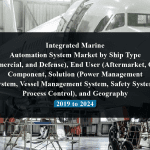OVERVIEW
The Airborne Radars Market is currently valued at USD 15.8 billion in 2024 and will be growing at a CAGR of 8.3% over the forecast period to reach an estimated USD 23.6 billion in revenue in 2029. The airborne radars market is a dynamic sector within the aerospace and defense industry, characterized by constant technological advancements and evolving military requirements. These radars play a critical role in providing situational awareness, detecting and tracking targets, and guiding weapons systems in various airborne platforms such as fighter jets, helicopters, unmanned aerial vehicles (UAVs), and commercial aircraft. With the growing emphasis on modernizing defense capabilities, improving surveillance, and countering emerging threats, there is a significant demand for airborne radars equipped with advanced features like active electronically scanned array (AESA) technology, synthetic aperture radar (SAR), and multi-mode capabilities. Furthermore, the increasing integration of radar systems with other sensors and communication networks for enhanced interoperability and data fusion is shaping the market’s landscape. Major players in this market include leading defense contractors, electronics companies, and radar system integrators, who continually invest in research and development to stay competitive and address evolving customer needs.
Increasing defense budgets worldwide, particularly in regions like North America, Europe, and Asia-Pacific, are fueling procurement and modernization programs, thereby boosting the demand for advanced radar systems. Additionally, the escalating threat landscape, including conventional and asymmetric threats, is driving military forces to enhance their surveillance and reconnaissance capabilities, stimulating investments in airborne radar technology. Furthermore, the rise of unmanned aerial vehicles (UAVs) and the growing trend towards network-centric warfare are driving the need for highly capable radars that can provide real-time situational awareness and support complex mission scenarios. Moreover, the commercial aviation sector’s emphasis on improving aircraft safety, efficiency, and navigation capabilities is also contributing to market growth, with airlines and aircraft manufacturers investing in radar systems for weather monitoring, terrain mapping, and collision avoidance purposes.
Table of Content
Market Dynamics
Drivers:
Increasing defense budgets worldwide, particularly in regions like North America, Europe, and Asia-Pacific, are fueling procurement and modernization programs, thereby boosting the demand for advanced radar systems. Additionally, the escalating threat landscape, including conventional and asymmetric threats, is driving military forces to enhance their surveillance and reconnaissance capabilities, stimulating investments in airborne radar technology. Furthermore, the rise of unmanned aerial vehicles (UAVs) and the growing trend towards network-centric warfare are driving the need for highly capable radars that can provide real-time situational awareness and support complex mission scenarios. Moreover, the commercial aviation sector’s emphasis on improving aircraft safety, efficiency, and navigation capabilities is also contributing to market growth, with airlines and aircraft manufacturers investing in radar systems for weather monitoring, terrain mapping, and collision avoidance purposes.
Key Opportunities :
One significant opportunity is the integration of artificial intelligence (AI) and machine learning algorithms into radar systems, enabling enhanced target detection, classification, and threat assessment capabilities. Additionally, there is a growing demand for lightweight and compact radar solutions that can be seamlessly integrated into smaller airborne platforms such as UAVs and drones, presenting opportunities for companies to innovate in miniaturization and power efficiency. Moreover, the increasing emphasis on multi-domain operations and the integration of radar systems with other sensors and communication networks create opportunities for offering comprehensive, integrated solutions that enhance overall situational awareness and mission effectiveness. Furthermore, emerging markets in regions like the Middle East, Asia-Pacific, and Latin America present untapped opportunities for market expansion, driven by rising defense spending and modernization efforts.
Restraints :
The airborne radars market also faces several restraints that could potentially hinder its growth trajectory. One significant challenge is the stringent regulatory environment governing the export and transfer of radar technology, particularly for advanced systems with military applications. Export control regulations and international arms trade agreements can impose restrictions on the sale and transfer of certain radar technologies, limiting market access and constraining business opportunities for manufacturers. Additionally, budget constraints and fiscal pressures in key defense markets may lead to delays or cancellations of procurement programs, affecting demand for airborne radar systems. Moreover, the complexity and high cost associated with developing cutting-edge radar technologies pose barriers to entry for smaller companies and startups, limiting competition and innovation within the market. Furthermore, technical challenges such as spectrum congestion and electromagnetic interference could affect the performance and reliability of radar systems, requiring ongoing research and development efforts to mitigate these issues.
Regional Information:
• In North America, particularly in the United States, the airborne radars market is primarily driven by robust defense spending and modernization initiatives. The U.S. Department of Defense’s focus on enhancing military capabilities, including next-generation fighter jets, unmanned aerial vehicles (UAVs), and surveillance aircraft, creates significant opportunities for radar system manufacturers. Additionally, the presence of leading defense contractors and technological innovators fosters a competitive landscape, with companies investing in research and development to maintain technological superiority.
• In Europe, countries such as the United Kingdom, France, and Germany are investing in airborne radar systems to bolster their defense capabilities amidst evolving security threats. Moreover, collaborative defense programs such as the European Union’s European Defence Fund (EDF) and NATO initiatives drive cooperation and interoperability, providing opportunities for companies to participate in multinational projects.
• In the Asia-Pacific region, countries like China, India, and Japan are ramping up defense spending to modernize their armed forces, driving demand for advanced radar systems to enhance surveillance and reconnaissance capabilities.
Recent Developments:
• In January 2021, Northrop Grumman Corporation was awarded a contract by the US Air Force to support the Joint Surveillance Target Attack Radar System (Joint STARS).
• In January 2021, Northrop Grumman Corporation received a contract from the French government to supply E-2D Advanced Hawkeye airborne radar equipped command and control aircraft.
Key Market Players:
Lockheed Martin Corporation, Northrop Grumman Corporation, Raytheon Technologies Corporation, Thales Group, Saab AB, BAE Systems plc, Leonardo S.p.A., L3Harris Technologies, Inc., Elbit Systems Ltd.
Frequently Asked Questions
1) What is the projected market value of the Airborne Radars Market?
– The Airborne Radars Market is expected to reach an estimated value of USD 23.6 billion in revenue by 2029.
2) What is the estimated CAGR of the Airborne Radars Market over the 2024 to 2029 forecast period?
– The CAGR is estimated to be 8.3% for the Airborne Radars Market over the 2024 to 2029.
3) Who are the key players in the Airborne Radars Market?
– Lockheed Martin Corporation, Northrop Grumman Corporation, Raytheon Technologies Corporation, Thales Group, Saab AB, BAE Systems plc, Leonardo S.p.A., L3Harris Technologies, Inc., Elbit Systems Ltd.
4) What are the drivers for the Airborne Radars Market?
– Defense budgets, threat landscape, and the rise of unmanned aerial vehicles are driving increased demand for advanced radar systems. The commercial aviation sector is also investing in radar for safety, efficiency, and navigation, while the rise of UAVs and network-centric warfare further fuels this growth.
5) What are the restraints and challenges in the Airborne Radars Market?
– The airborne radars market faces challenges due to stringent regulatory environments, budget constraints, high costs, and technical issues. Export control regulations and international arms trade agreements limit market access, while budget constraints in defense markets may affect procurement programs. Technical issues like spectrum congestion and electromagnetic interference also require ongoing research and development.
6) What are the key applications and offerings of the Airborne Radars Market?
– The integration of AI and machine learning algorithms in radar systems offers opportunities for enhanced target detection, classification, and threat assessment. The demand for lightweight, compact radar solutions, multi-domain operations, and integrated solutions in emerging markets presents untapped market expansion opportunities.
7) Which region is expected to drive the market for the forecast period?
– North America is expected to have the highest market growth from 2024 to 2029
Why Choose Us?
Insights into Market Trends: Global Market Studies reports provide valuable insights into market trends, including market size, segmentation, growth drivers, and market dynamics. This information helps clients make strategic decisions, such as product development, market positioning, and marketing strategies.
Competitor Analysis: Our reports provide detailed information about competitors, including their market share, product offerings, pricing, and competitive strategies. This data can be used to inform competitive strategies and to identify opportunities for growth and expansion.
Industry Forecasts: Our reports provide industry forecasts, which will inform your business strategies, such as investment decisions, production planning, and workforce planning. These forecasts can help you to prepare for future trends and to take advantage of growth opportunities.
Access to Industry Experts: Our solutions include contributions from industry experts, including analysts, consultants, and subject matter experts. This access to expert insights can be valuable for you to understand the market.
Time and Cost Savings: Our team at Global Market Studies can save you time and reduce the cost of conducting market research by providing comprehensive and up-to-date information in a single report, avoiding the need for additional market research efforts.












